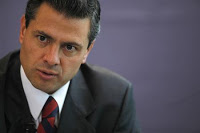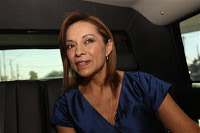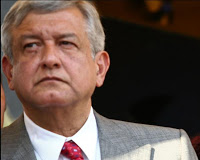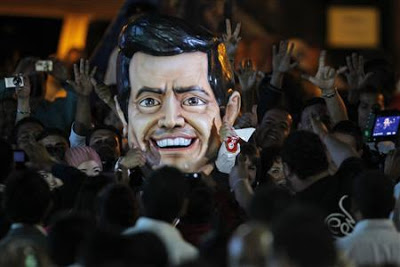The Mexican presidential election:
A veteran, a smile, and an image
So far a lack of enthusiasm and hope have characterized the campaign. Moderation, not confrontation, is the dominant theme.
By Philip L. Russell | The Rag Blog | April 19, 2012
Philip Russell and David Hamilton will discuss the upcoming presidential elections in Mexico and France on Rag Radio with Thorne Dreyer on KOOP 91.7-FM in Austin on Friday, April 20, 2012, from 2-3 p.m. (CDT). The show will be streamed live here.
March 30 marked the official start of the Mexican presidential campaign. Prior to that date candidates were officially prohibited from campaigning. The campaign lasts for 90 days, followed by a one-round election on July 1. The candidate with the most votes, even if they are less than a majority, wins.
The current front-runner, with 51 percent of the voters who declared a preference, is Enrique Peña Nieto, the telegenic, 45-year-old candidate of the Revolutionary Institutional Party (PRI).
After graduating from law school he went into politics, following the footsteps of generations of his forbears in his native State of Mexico. During the 1990s he held various positions in state government and later served in the state legislature. This, as well as his family connections, propelled him into the governorship of the state for the 2005-2011 term.
Peña Nieto, who is married to TV star Angélica Rivera, is widely viewed as all image and no content. As columnist Jorge Zepeda Patterson observed, ”People will vote for him because he’s good looking, because he looks presidential. Period. He and his wife form a fairy-tale couple portrayed favorably by the two major TV networks, both of which favor him.”
Peña Nieto stresses that his positive record as governor of the State of Mexico — Mexico’s most populous state — qualifies him to be president. Such a view is far from unanimous. Veteran human rights activist Sergio Aguayo commented that Peña Nieto’s record “oscillated between mediocrity and catastrophe.” In any case, Peña Nieto’s hand-picked successor won the gubernatorial race handily in 2011, bolstering the image of his governorship.
Peña Nieto emphasizes that it’s time to oust the incumbent National Action Party (PAN), since during the 12 years its two presidents have been in office both violence and the number of poor people have increased. He also stresses that as a result of what he calls a “dysfunctional state,” economic growth during the last decade has been slower than it has been during any other decade since the Depression.
Observers have attached the term Teflon candidate to Peña Nieto, since so far none of his gaffes have significantly lowered his approval rating. The most conspicuous of these gaffes was his not being able to — at a book fair yet! — state which three books have most influenced him. His strategy is to avoid unscripted encounters and to refrain from making bold proposals which might cost him some of his heterogeneous base.
 Peña Nieto received the nomination of his party by default, after it became obvious that he was far more popular than any other potential candidate. The PRI, which emerged from among the victorious generals of the Mexican Revolution of 1910-1917, is both Peña Nieto’s greatest asset and his greatest liability.
Peña Nieto received the nomination of his party by default, after it became obvious that he was far more popular than any other potential candidate. The PRI, which emerged from among the victorious generals of the Mexican Revolution of 1910-1917, is both Peña Nieto’s greatest asset and his greatest liability.
Many feel that if the PRI regains the presidency, there will be a return to the authoritarianism that characterized the party’s 71-year-long hold on the Mexican presidency. A more optimistic view portrays a new PRI constrained by a congress chosen by real elections and by a supreme court which actually rules against the executive branch.
Even though many are wary of a PRI return to Los Pinos, the presidential residence, the party offers by far the best get-out-the-vote machine in Mexico — the result of decades of political control and the 20 governorships currently in PRI hands. Such a machine could prove to be crucial in an election where grass-roots enthusiasm has been in short supply.
Josefina Vázquez Mota plays on her womanhood
Trailing Peña Nieto has been PAN candidate Josefina Vázquez Mota, with 28 percent of those declaring a candidate preference. She received an economics degree and subsequently served as a business consultant and public speaker.
She transitioned to politics after she caught the attention of the wife of the PAN governor of the state of Guanajuato, who introduced her to the governor. This resulted in her being nominated to a seat in Congress. She soon resigned her congressional seat to serve as President Fox’s secretary of welfare, a powerful post in the federal government.
In 2006 she resigned her cabinet post to manage Felipe Calderón’s foundering presidential campaign. After Calderón won his hotly disputed election, he appointed her as secretary of education. She had limited impact while serving in that post because she failed to wrest power from the powerful head of the teacher’s union. In 2009 she returned to the Chamber of Deputes where she became coordinator of the PAN delegation.
Her sights soon turned to the upcoming 2012 presidential race. The PAN alone among the parties staged a primary election to select its presidential candidate this year. Vázquez Mota won 54 percent of the 515,000 votes cast by registered PAN members and supporters, making her the first Mexican woman to be nominated for the presidency by a major party. The two males she defeated quickly united behind her candidacy.
Vázquez Mota is playing on her womanhood, announcing, “We are going to demonstrate that Mexico is ready for its first woman president.” She also noted in her victory speech after winning the primary that her experience raising a family would serve her as president.
She raises the specter of another PRI administration ushering back the authoritarianism and corruption associated with past PRI administrations. She is less clear on what she is for, other than improving education and creating 16 million scholarships so poor children can afford to remain in school longer.
She has proposed a coalition of parties to overcome the lack of decisive government action which has plagued both PAN administrations. Finally, although culture wars are much less significant than in the United States, she has stated her opposition to gay marriage and abortion.
 Given widespread rejection of the violence associated with incumbent PAN President Felipe Calderon’s crime-fighting policy and dissatisfaction with slow economic growth, Vázquez Mota’s greatest challenge is to establish her independence from the policies of the incumbent PAN president. At some point she must offer an alternative to what political scientist Silvia Gómez Tagle characterized as “more of the current policies of Felipe Calderón, which haven’t worked.”
Given widespread rejection of the violence associated with incumbent PAN President Felipe Calderon’s crime-fighting policy and dissatisfaction with slow economic growth, Vázquez Mota’s greatest challenge is to establish her independence from the policies of the incumbent PAN president. At some point she must offer an alternative to what political scientist Silvia Gómez Tagle characterized as “more of the current policies of Felipe Calderón, which haven’t worked.”
The PAN candidate also needs to overcome the perception that she smiles and talks a lot but is weak on content. Her speeches have been compared to those of motivational speakers — full of optimism and positive attitude, but lacking specifics. Columnist Sergio Sarmiento made this biting comment, “She prefers to fill the spaces with words rather than with ideas.”
Her party, the PAN, was organized in the 1930s as a conservative response to government anti-clericalism, President Lázaro Cárdenas’ (1934-1940) reforms, and the lack of democracy. In the last quarter of the 20th century the party saw a massive influx of businessmen, including future president Vicente Fox, who felt the PRI was wrecking the economy.
Since the PAN assumed power at the federal level in 2000, the party has suffered from its failure to achieve promised rates of economic growth and from violence associated with Calderón’s anti-crime campaign. It has become increasingly hard to determine how the PAN is different from the PRI, which it replaced.
Indeed Manuel Clouthier, son of an iconic PAN presidential candidate with the same name, left the party in 2012, declaring the PAN had “sunk to practices exactly like those which the PAN fought before taking power… It has been totally corrupted by power.”
Andrés Manuel López Obrador has moderated his image
The third major candidate is Andrés Manuel López Obrador, widely referred to simply as AMLO. He was the candidate of the Party of the Democratic Revolution (PRD) in 2006 and was declared to have lost the 2006 election by less than a percentage point after having maintained a commanding lead during most of the campaign.
Rather than leading the pack this year, only 20% of those polled expressed a preference for him, in large part due to his having alienated much of his base due to his refusal to recognize his election loss and his leading major protest demonstrations which tied up Mexico City for months.
AMLO first drew national attention protesting stolen elections in his home state of Tabasco and the national oil company’s running roughshod over those whose land and fishing grounds had been ruined by oil operations.
AMLO then moved to the national scene, heading the PRD and serving as mayor of Mexico City. His popularity as mayor positioned him for his 2006 presidential campaign, which was derailed by a massive wave of illegally funded attack ads.
For his 2012 campaign AMLO has attempted to moderate his image, declaring on the opening day of his campaign that “honesty, justice and love — lots of love,” would characterize his administration. Rather than referring to Mexico’s businessmen as a “mafia,” as he did in the past, he now courts them and refers to them as the motor of the economy.
Many question the sincerity of his shift in style between 2006 (and before) when he was much more confrontational. In fact the press often refers to the new López Obrador as AMLOve. Crucial to Lopez Obrador’s pulling out of third place will be convincing the Mexican public he is not a Romney-like flip-flopper who is tailoring discourse to what he believes the Mexican people want to hear.
The three keys to AMLO’s economic plans are lowering energy costs, combating monopolies, and lowering costs of government. Lowering the costs of electricity and gasoline would, although he doesn’t not acknowledge it, increase the already massive subsidy the government provides the middle and upper classes who consume a disproportionate share of energy.
 His goal of fighting monopolies is more straightforward, but risky in a campaign. Targeting monopolies would involve the taking on the two media giants controlling television — the very medium which will filter the information the vast majority of Mexicans rely on to make their candidate selection.
His goal of fighting monopolies is more straightforward, but risky in a campaign. Targeting monopolies would involve the taking on the two media giants controlling television — the very medium which will filter the information the vast majority of Mexicans rely on to make their candidate selection.
While promising not to increase debt, inflation or taxes, AMLO advocates stimulating the economy to create 1.2 million jobs a year. Rather, he promises to finance economic stimulus by ending monopolies, lowering salaries of overpaid government functionaries, and eliminating corruption.
Reversing decades of neoliberal policy, he urges a major role for government in implementing an industrial policy and creating public works. AMLO defends the icon of Mexican nationalism, the national oil company Pemex. In an AMLO administration no private capital will taint it. In addition, he proposes to end oil exports and refine Mexican oil locally in five new refineries.
AMLO shows his left roots in formulating security policy. Instead of advocating more guns and jails, he proposes ending drug-related violence by providing jobs and educational opportunities for young people so that they will not be tempted by employment offered by criminal gangs. More immediately he advocates creating a new federal police force which within six months would replace the military in combating organized crime.
If he is to move up during a short three-month campaign, AMLO must make some bold moves. As of now his economic plans smack of the revolutionary nationalism of 1960s and 1970s. Such policies indeed produced high growth then, but are of questionable relevance in today’s world. Similarly there is sound logic behind his statements on drug-related violence.
However it would take years for his economic policy, even if successful, to offer well-paid jobs to the millions flooding the labor market, the result of record high births in the 1990s. So far AMLO (and the other candidates) have failed to embrace the notion of drug legalization which is building momentum throughout Latin America.
AMLO received the 2012 nomination of the Revolutionary Democratic Party (PRD) after he edged out the mayor of Mexico City in a voter preference poll. Both presidential aspirants had previously agreed that the winner of the poll would be the left’s presidential candidate.
AMLO is not only the candidate of the PRD but of two other small left parties. This is an important advantage in a multiple-candidate one-round election. In 2006, the candidate of a small left party drew more votes than the difference between AMLO’s vote total and that of Felipe Calderón, the declared winner.
In addition AMLO has the support of a nationwide grassroots organization known as MORENA, which he has built up by traveling to all of Mexico’s 2000-plus municipios during the last six years.
While AMLO has the unified left behind him, his being the nominee of the PRD may well prove to be problematic. Coming up with policy suggestions has been difficult for the PRD — a dilemma shared by the left throughout post-Cold War Latin America.
Another challenge faced by the PRD is that the party has been so riven by factions that power struggles within the party often overshadow its policy proposals. Media coverage of the party frequently portrays the factions as “tribes.” Repeatedly the “tribes” have been so intent on gaining control of the PRD that they have attempted to rig elections for party posts. Such shenanigans hardly make the general public feel comfortable with the notion of the party administering Mexico.
Lack of enthusiasm characterizes campaign
The great unknown is what impact the internet and social media will have on the elections. Before March 30 all the candidates were making use of social media to get out their message since it did not fall under the government ban on campaigning before that date.
During the first week of the official campaign social media served to highlight a series of minor campaign snafus by the Vázquez Mota campaign — messages that appeared to be managed by the well-oiled PRI media machine. Social media could shape opinion, get out the vote, or simply get lost in the millions of TV spots Mexicans will be bombarded with before July 1.
As columnist Juan Enríquez Cabot observed, so far a lack of enthusiasm and hope have characterized the campaign. Moderation, not confrontation, is the dominant theme. Disappointment with the results of the transition to democracy in 2000 pervades the electorate. Compounding this is the notion, shared by many U.S. Republicans during the primary season, that the choices on the ballot are less than sterling.
Observers have also commented on the similarity of the candidates’ proposals. Zepeda Patterson declared the security proposals of the three candidates “are vague, ill defined, and virtually interchangeable.” All have proposed higher economic growth and fighting corruption — standard campaign fare for decades.
To close on a positive note, Mexicans do not feel corporations are people. Rather than following the Citizens United line of “reasoning,” Mexico strictly prohibits corporations from funding candidates or buying airtime to influence the election.
The amount private citizens can donate is sharply limited, allowing public financing to pay the bulk of campaign costs. TV campaign ads are broadcast without charge to either candidates or government. As a condition for getting a broadcast license, networks are required to provide a certain percent of airtime to the government. The government then allocates this airtime to campaigns so they can broadcast spots without being beholden to donors.
In addition the government makes substantial cash transfers to the political parties so they can campaign effectively and get their message out.
[Austin-based writer Philip L. Russell has written six books on Latin America. His latest is The History of Mexico: From Pre-Conquest to Present (Routledge). Frequently updated information on the Mexican presidential campaign can be found in chapter 30 of www.mexicofrompreconquesttopresent.com.]
The Rag Blog;”>



















As a mexican who’s trying to decide who to vote for, is amazing that the information used by Rusell is more than 60 days old. The preferences of the citizens for such candidate have moved and changed. Of course, the PRI partywould never accept the fact that their candidate has been a better laugh than the others. Unfortunately, just like in the media, Mr. Rusell shows a lot of preference for this candidate and that denotes a lack of respect to his readers. Please give information that’s serious, on time and up to date.
With respect, from mexico
Dear Anonymous:
Your are doing your country a disservice if you are using my blog to decide how to vote. I wrote the piece for readers who don’t even know party names, much less candidate names. Thus some of the information was indeed over 60 days old. I could of course post a daily or weekly blog on the elections, but I don’t think most readers want to plow through that much material.
As noted in the blog I do maintain a website mexicofrompreconquesttopresent.com where I post information on Mexico on a daily basis.
Philip Russell (the author)
Another Mexican here.
In the country everybody knows AMLO WON the 2006 election, but PAN had the power(with the first non-PRI president of our country, Vicente Fox) and they didn’t want to lost it.
What they did, they made AMLO look like a clown (he’s quite extrovert & has a strong southern accent), tried to put him in jail. Therefore, less people would give him their vote.
Still, on july 2nd 2006; in every polling place you’d see their results
1st place PRD AMLO
2nd PRI Roberto Madrazo
3rd PAN Calderón (our current president)
That night the 3 of them said they had won, on the TV they said AMLO & Calderon had a draw. (it made no sense)
Two days later they said Calderon had won; people asked for a recounting vote by vote, but the IFE (the mexican Electoral Institute) didnt do it.